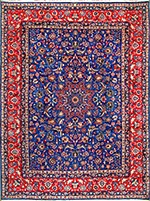Textiles Studies

Textile Research Works
Date of this Version
1991
Document Type
Article
Citation
Exhibition, The Textile Museum, Washington, DC, June 1, 1991 - February 16, 1992.
Abstract
Mamluk carpets present a paradox. For although they are among the most tantalizingly beautiful of all Oriental carpets, they are also the least understood. The answers to such questions as who made them, why they were made and for whom, and how they were used, are virtually unknown. These carpets, produced during the rule of the Mamluk sultans in Egypt in the late 15th century are arguably the finest ever produced anywhere. Mamluk carpets are distinguished from all other carpet-weaving traditions. In part, this distinction derives from the dominance and simplicity of geometric form (#R34.32.1): squares and rectangles, octagons and eight-pointed stars. Set within the broadly defined bold geometric forms are intricate designs that reflect a superlative play in the manipulation of color and form to create complex patterns that both please and tease the eye. The special beauty of Mamluk carpets is also marked by the jewel-like tones of red, green, and blue, suggestive perhaps of rubies, emeralds, and sapphires with imperial connotations. The wool is lustrous and has retained its silky sheen through the ages. Quality of materials and excellent craftsmanship are indicated by the equal number of knots per linear unit of measurement in both vertical and horizontal directions, enabling the execution of perfect squares and circles without elongation. There is no doubt that Mamluk carpets represent an extremely high level of technical competence. The designs are carefully executed to convey the appearance of perfection.
Included in
Art and Materials Conservation Commons, Art Practice Commons, Fiber, Textile, and Weaving Arts Commons, Indigenous Studies Commons, Museum Studies Commons


Comments
Copyright © 1991 The Textile Museum